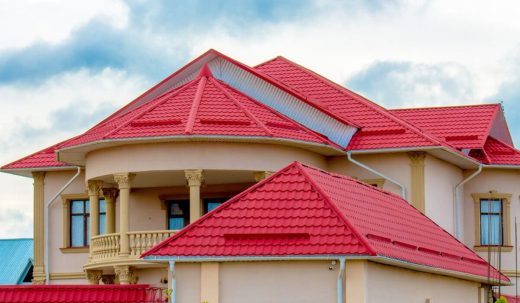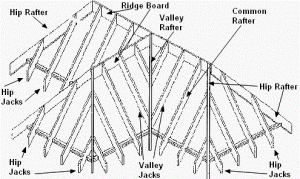Introduction:
When making a roof, it’s important to know how the building is assembled and how each part supports the whole. Rafters are a key part of a roof’s frame. They must be cut and measured carefully so that weight is evenly distributed and the building stays safe. In architecture and construction, a rafter is a structural component that supports a roof and helps transfer the roof’s weight to the building’s walls.
Rafters are typically made from wood or metal and are placed at regular intervals along the length of the roof. The shape and size of rafters can vary depending on the roof’s design and the structure’s weight and load-bearing requirements. In traditional construction, carpenters often cut rafters on-site using hand tools, but today pre-cut and pre-engineered rafters are commonly used for efficiency and cost-effectiveness.

Fig1: Rafter
Courtesy: housing.com
What is a Rafter?
A roof has many different parts that hold it together. One of these parts is called a rafter. More popular rafters are used to frame the roof and connect it to the outside walls. This method is also sometimes called “stick framing.” Rafters are usually built on-site, and their parts are cut to the size of 2x10s before they are placed on a ridge board that runs the length of the building. After that, ceiling joists connect the beams to the outside walls. The result is an arched ceiling that can be finished by filling it with insulation and plasterboard. You could also leave it as an empty room in the attic.
The rafters’ spacing and size depend on various factors, such as the type of roofing material, local building codes, and the load the roof must bear. Depending on the specific roof design, rafters can be designed in various shapes, such as triangular or trapezoidal cross-sections.
Types of Rafter:
1. Common Rafter:
A rafter connects a roof’s ridge board or beams to a wall’s top plate. It supports a roof’s sloping slope and is a horizontal framing part. Common rafters are spread evenly over the roof and fitted at a pitch or slope suitable for the roof’s design and construction. The weight of the roof covering, its span and local construction standards determine common rafter size and spacing. Traditional stick-framed roofs, including gable, hip, and shed roofs, use common rafters.

Fig2: Types of Rafters
Courtesy: civilclick.com
2. Jack Rafter:
A jack rafter is a type of framing member used in roof construction. It is typically installed between the hip or valley rafter and the common rafter of a roof and is used to help support the roof decking or sheathing. Jack rafters are typically shorter than common rafters and are cut at an angle to fit the roof’s pitch. They are installed in pairs, with one jack rafter on either side of the hip or valley rafter. The term “jack” may come from the fact that the jack rafters are “jacked up” to meet the level of the hip or valley rafter.
3. Valley Rafter:
A valley rafter is used in roof construction where two sloping roofs intersect at an angle, forming a valley. The valley rafter is installed along the line of intersection and supports the roofing material on both sides of the valley. It is typically a shorter rafter that runs perpendicular to the common rafters and may be cut at an angle to match the pitch of the sloping roof. The design and size of the valley rafter will depend on the roof’s pitch, span, and load requirements.
4. Hip Rafter:
A hip rafter is a structural component in a roof that runs diagonally from the corner of a building to the ridge line. It is a type of rafter used to support the end of a roof where two roof planes meet at an angle, such as at the peak of a gable roof or a hip roof. The hip rafter is typically installed at a 45-degree angle, and its main function is to provide support and stability to the roof structure. Properly installed hip rafters are crucial for the stability and longevity of a roof, as they transfer the roof’s weight to the supporting walls and foundation. They also help distribute the roof’s weight evenly, reducing the risk of structural damage over time.
5. Collar Ties:
Horizontal collar ties join two opposing roof rafters towards the apex of a gable roof. They support the roof and keep the rafters from spreading apart. Collar ties are perpendicular to the rafters around 1/3 down from the roof peak. They can be built of wood, steel, or engineered lumber and attached to the rafters using metal brackets or notches. Collar ties minimize roof drooping and protect against high winds and snow loads.
6. Ridge Board:
A ridge board is a horizontal timber board that runs along a roof’s peak, where two sloping sides meet. The ridge board supports roof rafters or trusses. It also attaches roof tiles and other roofing materials. The roof’s span and roofing materials’ weight determine a ridge board’s size and strength. The traditional timber-framed building uses a solid piece of lumber cut to fit the roof structure as the ridge board. Modern ridge boards are made of laminated veneer lumber (LVL) or other engineered wood products.
7. Purlin:
A purlin supports a roof or wall cladding horizontally. Metal buildings use wood or steel purlins. They are spaced regularly and set perpendicular to roof or wall framing parts like rafters or studs to provide a stable framework. Purlins support the roof covering and transfer its weight to the roof framework. Purlins support wall cladding and transfer wind loads to the wall structure. Gable, hip, valley, single-slope, and multi-slope roofs can use purlins.
Design of Rafter:
A rafter’s design depends on various factors, including the span of the rafter, the load it must support, and the spacing between the rafters. The rafter must be designed with an appropriate cross-sectional shape and size to ensure that it is strong enough to support the load. The most common cross-sectional shapes for rafters are rectangular or square, but other shapes, such as trapezoidal or circular, may also be used. The size of the rafter is typically determined by its span and the loads it must support, with larger rafters required for longer spans or heavier loads.
The design of a rafter also involves determining the appropriate spacing between the rafters. Local building codes typically determine the spacing but may also be influenced by other factors, such as the type of roofing material used and the local climate. In addition to the rafter’s shape, size, and spacing, other factors, such as the type of connection used to attach the rafter to the ridge or hip and the top plate of the supporting wall, must also be considered the design process.
Difference between Rafters and Trusses:
- Rafters are individual members that run from the ridge of the roof down to the eaves. They support the roof sheathing and any weight on it, such as snow or wind. Trusses, on the other hand, are prefabricated triangular structures made up of interconnected members. They are designed to provide more efficient use of materials and can span much longer distances than rafters.
- Rafters are typically built on-site by a carpenter, using individual pieces of lumber that are cut and joined together to form the roof framework. On the other hand, trusses are built off-site in a factory and shipped to the job site, ready to install. It makes them quicker and easier to install than rafters, as they require less on-site cutting and assembly.
- While rafters can be strong enough to support a roof, trusses are typically stronger due to their triangular shape, which distributes weight evenly across the structure. It allows trusses to span longer distances without the need for intermediate supports.
- Rafters are generally less expensive than trusses, as they require less engineering and manufacturing. However, they may be more labor-intensive to install, which can add to the overall cost of a roofing project.
Advantages of Rafter:
1. Strong and durable: Rafters are typically made of wood, a strong and durable material that can withstand the weight of the roof covering and resist structural loads over time.
2. Versatile: Rafters can be designed in various sizes and shapes to suit roof types and building designs. This versatility allows for flexibility in design and construction.
3. Cost-effective: Rafters are relatively inexpensive and require minimal maintenance compared to other roofing materials.
4. Energy-efficient: Rafters can be designed to provide insulation and ventilation, which can help to improve energy efficiency and reduce heating and cooling costs.

5. Aesthetically pleasing: Rafters can add an aesthetic appeal to the interior and exterior of a building. They can be exposed to create a rustic or contemporary look or concealed for a more traditional appearance.
Disadvantages of Rafter:
1. Limited span: Rafters have a limited span, so they may not be suitable for roofs with large spans. In such cases, it may be necessary to use additional support structures or other types of roof framing.
2. Requires additional insulation: Rafters typically require additional insulation to meet building codes and energy efficiency standards. It can add to the cost of roof construction.
3. Difficult to modify: Once installed, it can be difficult to modify or adjust the positioning of the rafters. It can make it challenging to accommodate roof design changes or make repairs or alterations.
4. Vulnerable to moisture: Rafters can be vulnerable to moisture damage if not properly treated or sealed. It can lead to rot, decay, or mold growth, compromising the roof’s structural integrity.
5. Requires skilled labor: Installing rafters requires skilled labor, which can increase the cost of construction. Additionally, installation errors can compromise the roof’s structural integrity and lead to costly repairs.
Conclusion:
A rafter is a structural element in a roof that supports the roof covering and helps transfer the roof’s weight to the walls or beams. Rafters are typically inclined beams that run from the ridge or peak of the roof down to the eaves or edge of the roof. The size and shape of the rafters will also depend on the design of the roof and the load it must support.
References:
1. Rafters: Functions, Types, Design, and Installation – Structville. (2022, May 31). Structville. https://structville.com/rafters-functions-types-design-and-installation
2. Rafters & its Classification: All You Need to Know. (2017, July 11). Rafters & Its Classification: All You Need to Know. https://gharpedia.com/blog/rafters-its-classification-all-you-need-to-know/
3. Desk, H. N. (2022, October 31). Rafters Meaning: Differences, Advantages, and Disadvantages. Housing News. https://housing.com/news/roof-rafters-everything-you-need-to-know/
4. A. (2021, December 22). What Are Roof Rafters? How Rafters Work in Roof Framing. MT Copeland. https://mtcopeland.com/blog/what-are-rafters/
5. Rafters vs. Trusses – Difference between Rafter and Truss – Engineering Feed. (2001, February 23). Rafters Vs Trusses – Difference Between Rafter and Truss – Engineering Feed. https://engineeringfeed.com/rafters-vs-trusses
If you have a query, you can ask a question here.


